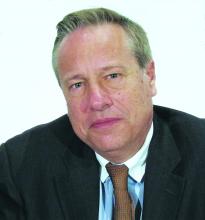NATIONAL HARBOR, MD. – If positive, a major ongoing phase 3 trial of CSL112, an agent designed to promote efflux of cholesterol from macrophages, is positioned to prove the HDL hypothesis, according to an outline of the rationale of the trial at CRT 2020 sponsored by MedStar Heart & Vascular Institute.
“Twenty papers now show better efflux means better outcomes independent of standard risk factors” and “we know this drug improves efflux,” explained C. Michael Gibson, MD, an interventional cardiologist at Beth Israel Deaconess Hospital, Boston.
The HDL hypothesis was derived from the Framingham Heart Study, which correlated high levels of HDL cholesterol with a reduced risk of adverse cardiovascular (CV) outcomes, according to Dr. Gibson. Just as elevated LDL proved to be a treatable risk factor for CV events, reduced HDL was the target of numerous trials to achieve the same types of benefits.
All have failed.
The problem has been in seeing HDL as a number without addressing its function, Dr. Gibson said. In essence, he believes “the HDL hypothesis not been really tested to date.”
CSL112 is a novel formulation of apolipoprotein A-1 (apoA-1) that has been purified from human plasma and reconstituted to form HDL. In the experimental and clinical setting, including the AEGIS I pilot study, weekly infusions of CSL112 have been associated with a degree of cholesterol efflux that predicts major CV risk reductions.
At the same time that the multinational event-driven AEGIS II trial will determine whether cholesterol efflux with CSL112 does translate into protection from CV events, it will also examine the HDL side of the lipid equation. Dr. Gibson said that it is specifically designed to circumvent the weaknesses of previous efforts to target HDL for reducing CV risk.
“The previous studies were conducted in the wrong patients with the wrong drugs given in the wrong doses at the wrong times,” said Dr. Gibson, who is also professor of medicine at Harvard Medical School, Boston.
One major difference from previous trials is that AEGIS II is enrolling patients with an acute coronary syndrome rather than stable atherosclerosis. Many of those being enrolled have had a recent event. Also, rather than raising HDL, the goal of CSL112 is to increase cholesterol efflux, which is now considered to be the key function of HDL. Furthermore, the time frame for the primary outcome, which is a composite of major adverse cardiac outcomes (MACE), is 90 days rather than several years.
In patients with ACS, “it is the early period of vulnerability where efflux of cholesterol really appears to have the greatest influence on outcomes,” Dr. Gibson explained.
The failure of previous efforts to treat HDL now appears to be based on an incomplete understanding of the goals, according to Dr. Gibson. The doomed cholesteryl ester transfer protein (CETP) drugs, for example, effectively increased HDL levels, but generated a form of HDL that “was not all that functional.”
He noted that niacin raises HDL but has off-target effects. Apo-A1 Milano, a mutant variation of apo-A1, is now understood to reduce the endogenous form, which Dr. Gibson said might explain its counterproductive effect on CV protection.
Using a garbage truck analogy to explain the growing appreciation of factors involved in cholesterol accumulation in the macrophage, Dr. Gibson characterized ABCA1, a transporter protein sitting on the surface of the macrophage, as the loader. He described LCAT (lecithin-cholesterol acyltransferase), an enzyme that converts cholesterol into cholesteryl ester, as the compactor. He sees CRL112 as an empty garbage truck sent into the macrophage to reverse the process.
“We are moving beyond thinking of HDL as a number to try to better appreciate its function,” Dr. Gibson said.
The AEGIS II trial was opened in March of 2018. It has a planned enrollment of 17,400 patients, with an estimated completion date of October 2021.
Dr. Gibson reports financial relationships with Bayer, Janssen, Johnson & Johnson, and CSL Behring, the sponsor of the AEGIS II trial.


